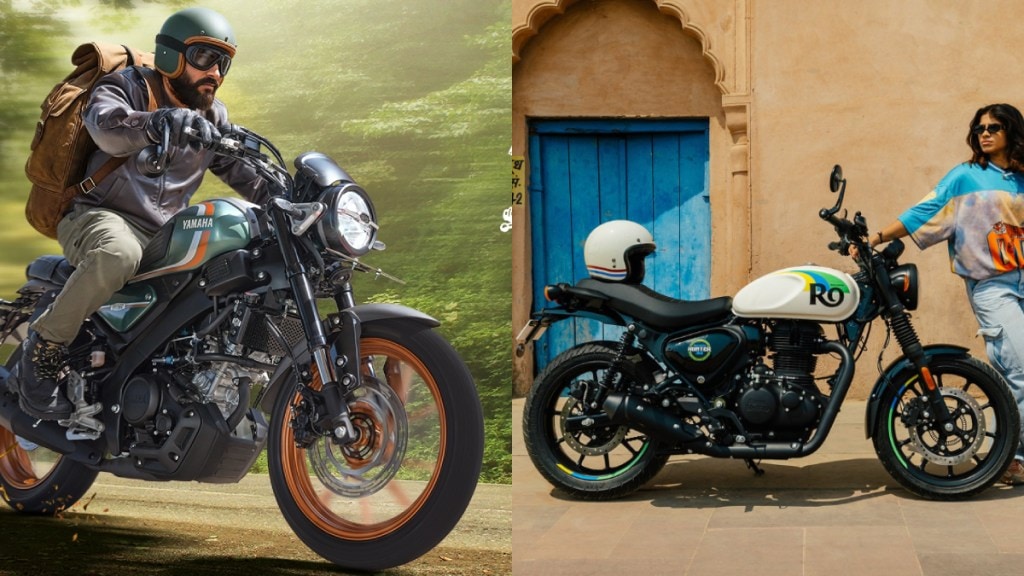The Royal Enfield Hunter 350 has dominated the affordable neo-retro motorcycle segment in India over the past few years, beating its competition from TVS and Java-Yezdi. Even Triumph’s Speed T4 couldn’t dethrone the Hunter 350 from its sales chart position. However, Yamaha has launched the XSR 155 in India and priced it competitively enough to make the Hunter 350 worry. In fact, a quick look at the on-paper specifications makes the Yamaha XSR 155 seem like a motorcycle tailored for Indian conditions.
Hence, if you have less than Rs 2 lakhs to spend on a motorcycle with the neo-retro charm and a beefy performance profile, which of these two machines is ideal? Let’s find out.
Yamaha XSR 155 vs Royal Enfield Hunter 350: Design
Both bikes nail the retro design approach with a hint of modern flair to cement the on-road presence. The Hunter 350 is styled as a classic British-inspired compact roadster with a simple, muscular silhouette, a teardrop fuel tank, and a low, approachable stance. The low seat height of 795mm makes it a lot more accessible to short riders, and coupled with a carefully assorted choice of colours, the Hunter 350 continues to be a handsome motorcycle, even after all these years.
The Yamaha XSR 155, by contrast, is more of a Japanese neo-retro design that shows its DNA of a sportsbike. Based on the MT-15, it flaunts a sophisticated round LED headlight, a sculpted tank, and exposed technical bits like the gold-finished Upside-Down (USD) front forks. At a mere 137 kg (kerb), the XSR is over 40 kg lighter than the Hunter 350 (181 kg), instantly giving it an advantage in agility and city maneuvering. However, the seat is positioned a tad higher at 810mm, which could restrict it to taller riders.
Yamaha XSR 155 vs Royal Enfield Hunter 350: Engine and Performance
The Hunter 350 uses the tried-and-tested 349cc, single-cylinder, air/oil-cooled J-series engine. This long-stroke engine is built for relaxed cruising and city tractability, delivering a hefty 20.2 bhp at 6,100 RPM and a robust 27 Nm of torque at just 4,000 RPM. Paired with a 5-speed gearbox, its strength lies in its low-end pull, making it ideal for effortless city riding.
The XSR 155 counters with new technology. Its 155cc, liquid-cooled, 4-valve engine, borrowed from the Yamaha R15, is an engineering marvel in its class. Thanks to Variable Valve Actuation (VVA), it produces a potent 18.1 bhp at a 10,000 RPM and 14.2 Nm of torque at 7,500 RPM. The XSR, with its 6-speed gearbox, is a high-revving, aggressive motorcycle, prioritising slick performance and top-end rush over brute force.
Note that both bikes come equipped with an assist and slipper clutch.
Yamaha XSR 155 vs Royal Enfield Hunter 350: Suspension and Ride
The XSR 155 takes a clear lead in hardware with its premium upside-down (USD) front forks and a linked rear monoshock, underpinned by Yamaha’s athletic Deltabox frame. This combination delivers sharp handling and stability, offering a distinctly modern, sporty ride.
The Hunter 350 uses a more conventional setup: telescopic front forks and twin-tube emulsion shock absorbers at the rear. While this setup is traditional, Royal Enfield has tuned the Hunter’s short wheelbase and suspension to be noticeably pliant and nimble for city use, compensating for its weight.
Yamaha XSR 155 vs Royal Enfield Hunter 350: Fuel Efficiency
Unsurprisingly, the smaller Yamaha engine wins the efficiency contest. The XSR 155 has a high reported mileage of around 45-48 kmpl, making it significantly more economical to run than the Hunter 350, which offers an ARAI-certified 36.2 kmpl.
Yamaha XSR 155 vs Royal Enfield Hunter 350: Pricing
In terms of pricing, the Hunter 350 is generally more accessible, starting at approximately Rs 1.38 lakh (ex-showroom) for its Retro variant. The single-variant Yamaha XSR 155 is priced slightly higher, around Rs 1.50 lakh (ex-showroom). However, the loaded variant of the Hunter 350, with alloy wheels, tubeless tyres, dual-channel ABS and advanced instrumentation, costs Rs 1.62 lakh, which is higher than the Yamaha.
Yamaha XSR 155 vs Royal Enfield Hunter 350: Smart features and Safety
The XSR 155 offers a superior safety net, featuring a standard dual-channel ABS across all markets and, crucially, the Traction Control System (TCS), which is a rare feature in this segment.
The Hunter 350’s safety and features vary by variant. While the top models get Dual-Channel ABS (the base variant often only offers single-channel), its smart features center around the optional Tripper navigation pod (for turn-by-turn directions) and a standard USB Type-C charging port.
Yamaha XSR 155 vs Royal Enfield Hunter 350: Conclusion
While both motorcycles are tempting in their own might, they cater to highly different kind of riders.
The Royal Enfield Hunter 350 is the ideal choice for the rider who prioritises relaxed city commuting, the authoritative thump of a long-stroke 350cc engine, and a torque-rich power delivery. Its lower seat height and accessible pricing (for the base model) make it an excellent entry point into the Royal Enfield lineup.
The Yamaha XSR 155 is for the rider who values cutting-edge technology, razor-sharp handling, and superior fuel economy. It is a lightweight, agile, and premium motorycle whose sophisticated engine, USD forks, and standard Traction Control offer a modern, spirited ride wrapped in a retro skin.
